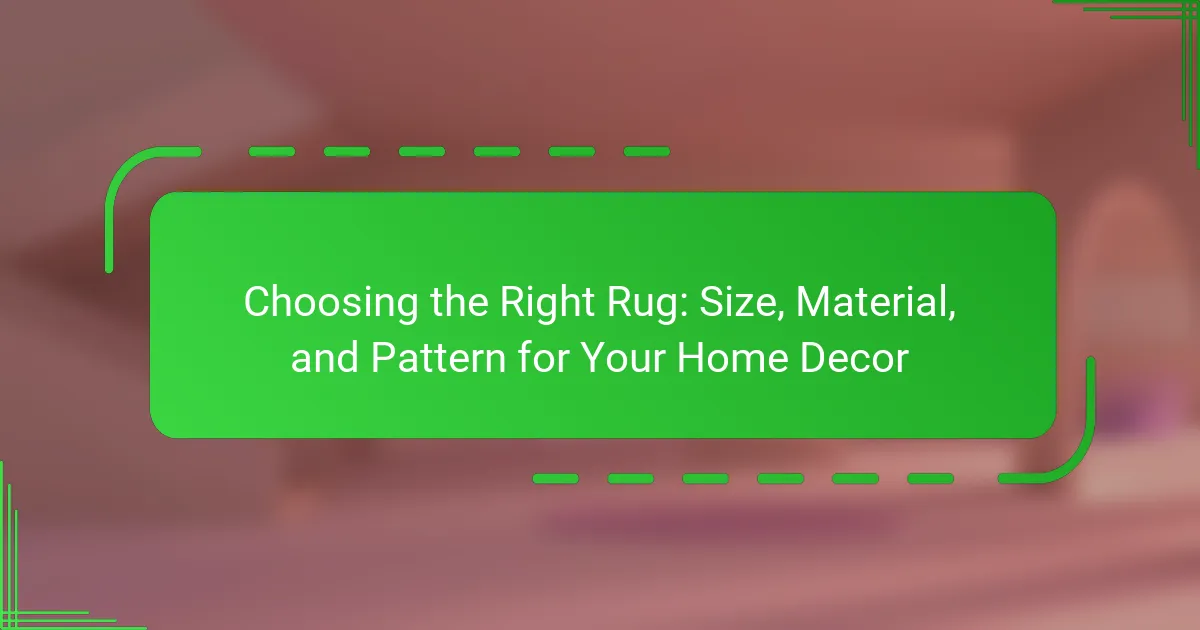Choosing the right rug is essential for enhancing home decor and functionality. Key factors to consider include size, material, and pattern. The size of the rug should align with the room’s dimensions and furniture arrangement to avoid a disjointed or overwhelming appearance. Material influences durability and maintenance, with options ranging from resilient wool to easy-care synthetic fabrics. Additionally, the rug’s pattern can significantly impact the room’s aesthetic, with bold designs serving as focal points and subtle patterns complementing existing decor. Understanding these elements is crucial for selecting a rug that fits both lifestyle needs and aesthetic preferences.

What Factors Should You Consider When Choosing a Rug?
When choosing a rug, consider size, material, and pattern. The size should fit the room’s dimensions and furniture layout. A rug that is too small can make a space feel disjointed. Conversely, a rug that is too large can overwhelm the area. Material affects durability and maintenance. Wool rugs are known for their resilience, while synthetic options are often easier to clean. Pattern can influence the room’s overall aesthetic. Bold patterns can serve as focal points, while subtle designs can complement existing decor. Each of these factors plays a critical role in achieving the desired look and functionality in your home.
How Does Rug Size Impact Your Home Decor?
Rug size significantly impacts home decor by influencing the overall aesthetics and functionality of a space. A larger rug can create a cohesive look by unifying furniture arrangements. It can also define areas within open floor plans, making spaces feel more intentional. Conversely, a smaller rug may lead to a disjointed appearance if it does not adequately anchor the furniture.
For example, a rug that extends under furniture helps to visually connect pieces, promoting harmony. According to design principles, the ideal rug size should allow for at least the front legs of furniture to rest on it, enhancing the room’s balance. Additionally, rug size affects the perception of room dimensions; larger rugs can make a space feel more expansive, while smaller rugs can sometimes make a room feel cramped.
What are the standard rug sizes available?
Standard rug sizes include 2×3 feet, 3×5 feet, 4×6 feet, 5×8 feet, 6×9 feet, 8×10 feet, and 9×12 feet. These dimensions are commonly used in residential and commercial settings. Each size serves different purposes and fits various room layouts. For example, a 5×8 feet rug is ideal for a small living room, while an 8×10 feet rug works well in larger spaces. The availability of these sizes is consistent across most retailers. This standardization helps consumers select appropriate rugs for their specific needs.
How do you measure your space for the right rug size?
To measure your space for the right rug size, start by determining the area you want to cover. Use a measuring tape to find the length and width of the space. For living rooms, leave a gap of at least 18 inches from the walls. In dining areas, the rug should extend beyond the table by 24 to 30 inches. For bedrooms, ensure the rug fits under the bed or extends at least 18 inches on each side. This approach creates a cohesive look and enhances comfort. Accurate measurements ensure the rug complements your furniture arrangement and room dimensions effectively.
What Materials Are Best for Different Areas of Your Home?
For different areas of your home, the best materials include wool, nylon, polyester, and cotton. Wool rugs are durable and stain-resistant, ideal for high-traffic areas. Nylon offers resilience and easy maintenance, making it suitable for living rooms. Polyester is soft and colorfast, perfect for bedrooms. Cotton rugs are lightweight and washable, great for kitchens and bathrooms. Each material provides specific benefits aligned with the functionality of the space.
What are the pros and cons of natural fiber rugs?
Natural fiber rugs have both advantages and disadvantages.
Pros include durability. Natural fibers like jute and sisal are strong and long-lasting. They are also eco-friendly, made from renewable resources. These rugs offer a unique aesthetic, adding warmth and texture to a space. Additionally, they are often less expensive than synthetic alternatives.
Cons include limited softness. Natural fiber rugs can be rough underfoot, which may not be comfortable in certain areas. They are also prone to staining, as many natural fibers are not water-resistant. Maintenance can be challenging, requiring professional cleaning for deep stains. Finally, natural fiber rugs can fade in direct sunlight, affecting their appearance over time.
How do synthetic rugs compare to natural materials?
Synthetic rugs are typically more durable and stain-resistant than natural materials. They are often made from materials like nylon or polypropylene, which are engineered for longevity. Natural rugs, such as those made from wool or cotton, offer a softer feel and are often more eco-friendly. However, they can be more susceptible to stains and wear over time. Synthetic rugs are easier to clean, requiring just soap and water, while natural rugs may need professional cleaning. Additionally, synthetic options are usually more affordable than their natural counterparts. Studies show that synthetic materials can withstand heavy foot traffic better than natural fibers.
How Do Patterns Influence the Aesthetic of a Room?
Patterns significantly influence the aesthetic of a room by adding visual interest and depth. They can create focal points, guide the eye, and define spaces. For example, geometric patterns can evoke a modern feel, while floral designs may impart a softer, more traditional ambiance.
The size and scale of patterns also play a crucial role. Larger patterns can make a space feel more expansive, while smaller patterns can add texture and detail. According to a study by the Journal of Interior Design, the use of patterns can enhance emotional responses to spaces, affecting mood and perception.
Incorporating patterns thoughtfully can harmonize with other elements, such as color and texture. This synergy can elevate the overall design and create a cohesive look. Therefore, patterns are essential in shaping the aesthetic experience of a room.
What are the most popular rug patterns and their meanings?
The most popular rug patterns include geometric, floral, tribal, and abstract designs. Geometric patterns symbolize order and modernity. They often feature repeating shapes and lines. Floral patterns represent nature and beauty. These designs can evoke a sense of warmth and tranquility. Tribal patterns reflect cultural heritage and storytelling. They often incorporate bold colors and intricate motifs. Abstract patterns convey creativity and individuality. These designs can serve as a focal point in a room. Each pattern brings its own unique meaning and aesthetic to home decor.
How do you choose patterns that complement your existing decor?
To choose patterns that complement your existing decor, first analyze your current color scheme. Identify dominant colors and undertones in your space. Next, consider the style of your decor, whether it’s modern, traditional, or eclectic. Select patterns that reflect or enhance this style. For instance, geometric patterns work well in contemporary settings, while floral designs suit traditional decor. Additionally, balance busy patterns with solid colors to avoid overwhelming the space. Use a color wheel to identify complementary colors that harmonize with your existing palette. Finally, test fabric swatches in your space to see how they interact with lighting and other decor elements.

How Can You Ensure Your Rug Fits Your Lifestyle?
To ensure your rug fits your lifestyle, assess your daily activities and the rug’s durability. Consider the foot traffic in the area where the rug will be placed. High-traffic areas require rugs made of durable materials like polypropylene or nylon. For homes with pets or children, opt for stain-resistant fabrics. Evaluate the rug’s size to match the room’s dimensions and furniture layout. A well-sized rug can enhance the room’s aesthetic and functionality. Additionally, choose a pattern that complements your existing decor. Neutral patterns can offer versatility, while bold designs can make a statement.
What Lifestyle Considerations Should You Keep in Mind?
When choosing a rug, consider your lifestyle needs. High-traffic areas require durable materials like nylon or polyester. If you have pets, opt for stain-resistant fabrics. Allergies may necessitate low-pile rugs that are easier to clean. For children, choose rugs with non-toxic materials and soft textures. Room size influences rug dimensions; larger rooms benefit from bigger rugs for a cohesive look. Lastly, consider maintenance; some materials require more care than others, impacting long-term satisfaction.
How do pets and children affect your rug choice?
Pets and children significantly influence rug choice by necessitating durable, stain-resistant materials. Rugs made from synthetic fibers are often preferred for their resilience. Natural fibers, like wool, may be less practical due to their susceptibility to stains. Patterns that camouflage dirt, such as busy designs, are advantageous in homes with kids and pets. Additionally, low-pile rugs are easier to clean and maintain. According to the American Society for the Prevention of Cruelty to Animals (ASPCA), households with pets require careful consideration of rug safety and durability. Choosing the right rug can minimize wear and tear while ensuring a safe environment for children and pets.
What maintenance requirements should you consider?
Regular cleaning is essential for maintaining rugs. Vacuuming should be done weekly to remove dirt and debris. Spot cleaning is necessary for stains; use mild detergent and water. Professional cleaning is recommended every 1-2 years for deep cleaning. Avoid excessive moisture to prevent mold and mildew. Rotate rugs periodically to ensure even wear. Protect rugs from direct sunlight to prevent fading. Use rug pads to prevent slipping and extend lifespan.
How Do You Select a Rug That Enhances Your Home’s Style?
To select a rug that enhances your home’s style, consider the existing decor and color scheme. Choose a rug that complements the room’s overall aesthetic. For example, a modern room may benefit from geometric patterns, while a traditional space might suit floral designs. Assess the size of the room to determine the appropriate rug dimensions. A larger rug can create a cohesive look, while smaller rugs can define specific areas. Material is also crucial; natural fibers like wool offer durability and comfort. Finally, consider the rug’s texture, as it can add depth and interest to the space. These factors collectively ensure the rug enhances your home’s style effectively.
What styles of rugs are trending currently?
Bohemian and vintage rugs are currently trending. These styles offer a unique blend of colors and patterns. Bohemian rugs often feature intricate designs and vibrant hues. Vintage rugs provide a sense of history and character. Geometric patterns are also popular, adding a modern touch to spaces. Natural fibers, such as jute and wool, are favored for their durability and eco-friendliness. Textured rugs, including shag and tufted styles, are gaining popularity for their comfort. Overall, these trends reflect a desire for personalization and warmth in home decor.
How can you mix and match rugs with different styles?
To mix and match rugs with different styles, start by identifying a common color palette. Choose rugs that share similar colors to create visual harmony. Next, consider varying the patterns; pairing a bold patterned rug with a subtle one can add depth. Additionally, vary the textures for contrast; a plush rug can complement a flatweave. Ensure the sizes are proportionate to the space, allowing for overlapping without overcrowding. Layering rugs can enhance the aesthetic; place a smaller rug on top of a larger one for added interest. Finally, maintain balance by distributing the styles evenly throughout the room. This approach creates a cohesive look while showcasing individual rug designs.

What Are Some Common Mistakes to Avoid When Choosing a Rug?
Common mistakes to avoid when choosing a rug include selecting the wrong size. A rug that is too small can make a room feel disjointed. Conversely, an oversized rug may overwhelm the space. Another mistake is ignoring the material. Different materials offer various durability and maintenance levels. Choosing a rug that clashes with existing decor is also common. This can disrupt the overall aesthetic of the room. Lastly, failing to consider the rug’s pattern can lead to visual chaos. Patterns should complement the furniture and wall colors for harmony.
What are the pitfalls of selecting the wrong rug size?
Selecting the wrong rug size can lead to several pitfalls. An incorrectly sized rug can disrupt the visual balance of a room. A rug that is too small may make the space feel disjointed. It can also create an awkward flow, as furniture may not sit comfortably on or around the rug. Conversely, a rug that is too large can overwhelm the space. It may obscure flooring and make the room feel cramped. Additionally, improper sizing can affect functionality. For example, a small rug in a dining area may not protect the floor adequately. According to interior design experts, choosing the right rug size enhances cohesion in decor. Proper sizing ensures that furniture arrangements feel intentional and harmonious.
How can the wrong material affect your rug’s longevity?
The wrong material can significantly reduce a rug’s longevity. Rugs made from low-quality materials may wear out quickly. Natural fibers like wool are durable, while synthetic fibers may degrade faster. For example, nylon rugs can lose their shape and color over time. Additionally, rugs made from materials like polyester may not withstand heavy foot traffic. This leads to fraying and fading, reducing the rug’s lifespan. Rugs exposed to moisture can also suffer from mold if made from unsuitable materials. Consequently, selecting the right material is crucial for maintaining a rug’s condition over time.
What Tips Can Help You Make the Best Rug Choice?
To make the best rug choice, consider the size, material, and pattern. First, measure the space where the rug will be placed. A rug should fit the room’s layout and furniture arrangement. Next, choose a material that suits your lifestyle. For high-traffic areas, durable materials like nylon or polypropylene are ideal. For comfort, consider wool or cotton. Then, select a pattern that complements your decor. Neutral patterns provide versatility, while bold designs can serve as a focal point. Lastly, check the rug’s maintenance requirements. Some materials require more care than others. These considerations ensure that the chosen rug enhances the room’s aesthetic and functionality.
How can you test a rug’s color and texture before buying?
To test a rug’s color and texture before buying, you should physically examine the rug in person. This allows you to see the true color under natural lighting. Additionally, you should touch the rug to feel its texture. Different materials have distinct textures, such as softness or coarseness. You can also compare the rug’s color with your home decor. This helps ensure it complements your existing colors. If possible, take a swatch home to see how it looks in your space. This method provides a better understanding of how the rug will fit into your home.
What are the best practices for placing a rug in your space?
Place a rug to define areas within a room. Position it under key furniture pieces to create a cohesive look. Ensure at least the front legs of sofas and chairs are on the rug. This helps anchor the furniture and provides a sense of balance. For dining areas, the rug should extend beyond the table and chairs. This allows for comfortable movement when seated. In bedrooms, place the rug under the bed or at least at the foot of the bed for warmth and comfort. Maintain a consistent border of floor space around the rug for visual clarity. Choose a size that complements the dimensions of the room. A rug that is too small can make the space feel disjointed.
Choosing the Right Rug encompasses essential factors such as size, material, and pattern, which significantly impact home decor. The article outlines how to select the appropriate rug size based on room dimensions and furniture layout, ensuring a cohesive look. It examines various materials suitable for different areas of the home, detailing their durability and maintenance requirements. Additionally, the influence of patterns on aesthetic appeal is discussed, along with tips for integrating rugs into existing decor while considering lifestyle factors like foot traffic and household needs.
